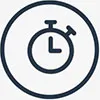Army Cognitive Test
All you need to know about the Army Cognitive Test by the British Army.
What is the Army Cognitive Test?
The Army Cognitive Test (ACT) is a psychometric test administered by the British Army. The purpose of the ACT is to determine which military occupations you qualify for.
Your performance on the ACT, along with other assessment measures, will influence your career options in the British Army.
The ACT is a revised version of the previously applied British Army Recruit Battery (BARB) test.
The higher you score, the more career options are available to you.
So, it’s extremely important that you thoroughly prepare for the test.
What can I expect on the ACT?
The five sections of the Army Cognitive Test are:
- Orientation – Assesses memory and spatial ability.
- Error Detection – Measures attention to detail.
- Number Fluency – Assesses mental arithmetic ability and memory.
- Word Rules – Tests memory and pattern recognition.
- Deductive Reasoning – Evaluates logical thinking
Each section is strictly timed and contains a virtually unlimited number of questions.
What questions are on the ACT?
The ACT consists of five separate sections: Orientation, Error Detection, Number Fluency, Word Rules, and Deductive Reasoning. In the following few paragraphs, we will describe section in detail. We have also included example questions for each section.
Orientation
The Orientation section of the Army Cognitive Test (ACT) is designed to assess your ability to follow and apply rules while identifying correct spatial relationships between objects — in this case, arrows.
In this section, you will be presented with two rules that describe how the arrows should be positioned relative to each other. Your task is to memorize these rules and then identify the correct set of arrows that follow them.
You will be given two rules to remember.
- Rule 1: Describes the relative position and color of arrows (e.g., “Black ABOVE White”).
- Rule 2: Defines how specific arrow directions relate to one another (e.g., “Up Left BELOW Down Right”)
When you have understood and memorized the rules, you must select “Okay” to continue.
The rules will now be replaced with six sets of arrows and you must now select the set that correctly follows both rules.
Try an example below.
ACT Sample question – Orientation:
Read and remember the two rules given below.
White above White
Down right below Down left
When you are ready, press “Next”
Select the correct answer below:
Explanation:
Select your answer to display explanation.
The two rules are:
White above White
Down right below Down left
Error Detection
The Error Detection section of the Army Cognitive Test (ACT) assesses your ability to quickly and accurately identify differences between two nearly identical strings of characters. This section measures your attention to detail, focus, and ability to spot discrepancies under time pressure.
You will be shown two strings of characters that are either identical or contain small differences. You must determine the number of differences (if any) between the two strings. Once you’re ready, you will press “Next” and be given five answer options (0, 1, 2, 3, 4), representing the number of differences between the two strings.
Try an example question below.
ACT example question – Error Detection:
Count how many letters, numbers, and symbols differ between the two strings.
When you know the answer, select “Next”.
https://fran55li-fcomo.co.uk
https://fran55il-fcomo.co.ok
Choose the correct answer below:
Explanation:
Select your answer to display explanation.
There are three differences between the strings. The differences are marked below:
https://fran55li-fcomo.co.uk
https://fran55il-fcomo.co.ok
Number Fluency
The Number Fluency section of the Army Cognitive Test (ACT) assesses your ability to quickly process and compare numerical values. This section evaluates your mental arithmetic, memory, and decision-making speed.
You will be shown a single mathematical expression on the screen. Once you are ready, you press “Next”, and a second mathematical expression will appear.
After pressing “Next” again, you will be required to answer which of the two expressions are greater.
Because you cannot see both expressions at the same time, you must rely on your memory and quick calculation skills to answer correctly.
ACT example question – Number Fluency
Remember the first value:
32 + 69
Remember the second value:
34 × 3
Which is greater?
Explanation:
Select your answer to display the explanation.
The first value:
32 + 69 = 101
The second value:
34 x 3 = 102
Meaning that the second value is greater.
Word Rules
The Word Rules section of the ACT evaluates your verbal reasoning, memory, and ability to recall associations under time pressure, skills essential for following instructions and processing information efficiently.
You will first be shown three word categories that you must memorize. After clicking “Next,” the categories will be replaced with three words. Your task is to determine how many of the words match their corresponding categories in the same position. Before the answer options appear, you must click “Next” again, at which point the words will be hidden.
Try an example question below.
Read and memorize the categories below.
When you are ready, select “Next”.
Beverage Emotion Beverage
Look at the list. How many of the words match?
Select “Next” when you know the answer.
Coffee Anger Cookie
Select the correct answer.
Explanation:
Select your answer to display the explanation.
The words were:
Beverage Emotion Beverage
The categories were:
Coffee Anger Cookie
The first two words match their category, the last does not. The correct answer is 2.
Deductive Reasoning
The Deductive Reasoning section of the ACT assesses your ability to apply logical rules and make conclusions based on given relationships.
You will be presented with a set of logical rules describing relationships between different elements (e.g., ranking by size, happiness, speed, etc.). Below these rules you will be asked a question.
Your task is to deduce the correct answer by comparing the relationships established in the rules.
The relationships are usually comparative (e.g., “X is taller than Y” or “A is faster than B”) and require logical sequencing to determine the correct conclusion.
Try an example below.
Read the question and select “Next” when you have decided on your answer.
Tower shorter than School
School taller than Library
Which is tallest?
Select the correct answer.
Explanation:
Select your answer to display explanation.
Tower shorter than School. School taller than Library.
This means that the the school is taller than both the tower and the library. We do not know anything about the relationship between the tower and the library, but that is irrelevant to answering the question “Which is tallest”. The correct answer is “School”.
Try more ACT practice questions with our free Army Cognitive Test (ACT) practice test.
How does Army Cognitive Test scoring work?
The ACT does not have a pass or fail mark, but your score will determine which roles you qualify for.
Each candidate receives a General Trainability Index (GTI) score, which reflects their cognitive ability. The GTI score is calculated based on your performance across all sections of the test. Each section contributes to your overall GTI score, but the exact weighting is not publicly disclosed.
Performing well in all sections increases your chances of qualifying for more roles.
- Each Army job has a minimum GTI score requirement.
- Higher scores unlock more roles, including technical and intelligence-based positions.
- Lower scores may still qualify for roles, but options will be more limited.
Example:
- A GTI score of above 60 may qualify you for intelligence or engineering roles.
- A GTI score of below 40 may limit you to combat or support roles.
(Exact cut-off scores vary and are subject to Army recruitment policies.)
How to prepare for the Army Cognitive Test
Preparation is essential in obtaining a good score on the Army Cognitive Test (ACT). In reading our guide to the ACT, you have already covered the first point on our list of tips for preparing “Well in advance of the test day”.
Well in advance of the test day
- Know what to expect on the ACT.
- Familiarize yourself with the type of test questions on the ACT.
- Practice cognitive tests similar to the ACT to improve speed and accuracy.
- Improve number fluency by working on mental arithmetic.
- Train your logical reasoning by practicing pattern recognition and problem-solving.
- A healthy body is important for a healthy mind. Therefore, eat well, get enough sleep, and exercise regularly. Doing so will make a positive difference not only in your everyday life but also in your test results.
The day before the test
- The day before your test, make especially sure that you eat well and avoid alcohol.
- Arriving late for the test, or even just in time, can cause nervousness and bad results. Make sure you have everything ready the day before and that you know exactly where to go and how to get there.
- Get plenty of rest the night before the test.
Tips for taking the Army Cognitive Test
- On the day of your test, eat a good breakfast, even if you normally skip it. You need to keep your mental focus on your test and not on your hunger. If you really cannot stomach food, then try having a protein shake or smoothie. Eat brain-boosting food. This includes protein-rich foods, which can lead to greater mental alertness. Good food choices include eggs, nuts, yogurt, and cottage cheese.
- Read the directions for each test carefully before you begin the test.
- Remember that both time and accuracy are equally important in the ACT. You must work quickly without compromising accuracy.
- Try not to second-guess your answers — go with your first choice.
Preparation can make a huge difference in your test results. We strongly believe that our ACT preparation platform offers the best ACT preparation on the market.
Read more about our platform here.
Army Cognitive Test Preparation
Not simply practice questions but accurate ACT preparation materials that simulate the real thing.

Unlimited questions
Practice with an unlimited number of ACT test questions in all five sub-tests of the ACT.

Explained answers
Explained solutions teach you why an answer is correct, increasing your overall performance.

Test statistics
Detailed test statistics, progress reports, and performance charts help you track your progress.

Simulate the real ACT
Run a full-length Army Cognitive Test to simulate real test conditions.
